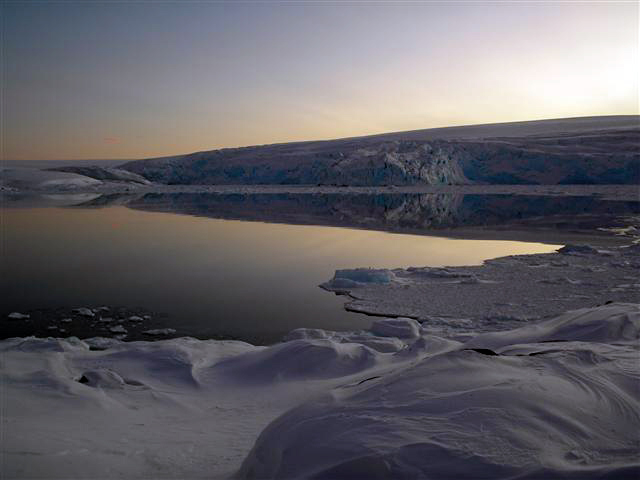Around the Continent—Research Station Updates
Catch up with the latest events at the U.S. Antarctic Program's research stations. McMurdo Station Take a look at Antarctica yourself by visiting the McMurdo Station Web camera |
McMurdo prepares to receive five August flightsPosted August 14, 2009
Things are ramping up at McMurdo Station 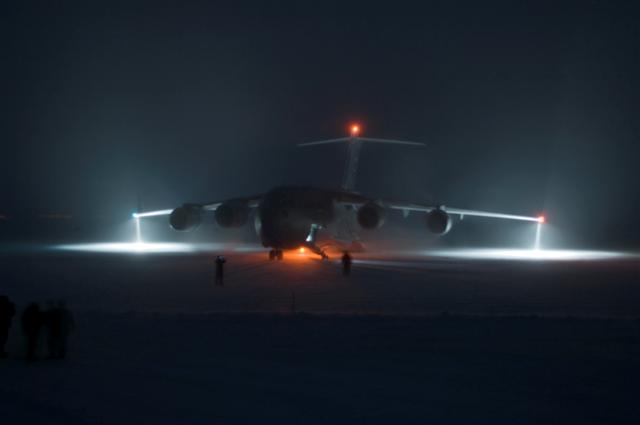
Photo Credit: Bill Henriksen/Antarctic Photo Library
A U.S. Air Force C-17 lands at Pegasus airfield during a special night mission in 2008. Another traning mission is scheduled for this year's Winfly.
In an inter-departmental push, the Pegasus White Ice Runway In order to accommodate the influx of new people on station, McMurdo winter-overs are working hard to re-open buildings and expand workspaces. Dormitories left “cold” during the winter are being warmed up, and the current residents are shuffling their accommodations to make room for roommates. This year all but two dormitories will be needed to house the larger-than-normal Winfly population. The extra people will include more firefighters who are coming in to complete department training on the Ice, more scientists, and personnel for the South Pole Traverse who need to get a jumpstart on their season. Those extra people also necessitate the arrival of additional kitchen and janitorial staff to support the population. While we winter-overs do not relish the expanding population, we eagerly await the arrival of fresh fruits and vegetables (“freshies”) and mail from home. The approaching summer also means our thoughts turn to plans off the Ice. Tuesday nights have been scheduled for travelogues in the dining hall, as people share photos and stories of past travel adventures, and inspire new ones. |
Palmer Station emergency teams train for the unexpectedPosted August 7, 2009
With ice filling in both Arthur Harbor and Hero Inlet, winter is making certain we know it’s here at Palmer Station It has been a month from the time the ARSV Laurence M. Gould Compared to the International Polar Year Instead, logistics personnel find their time taken up by inventory. FEMC members are now focusing more on finishing projects rather than helping science groups set up to go with their projects’ needs. This is a much more isolated winter, one in which we must be able to rely on each other. To that end, most folks have their normal jobs, but are also members of an emergency response team of some sort or another. The trauma team meets once a week for an hour for training. Topics can range from how to package patients for transport, how to take vital signs and to give sutures, and even how to take X-rays. Trauma team members also serve as assistants to the doctor when there are patients who need care. This could mean taking vitals over an overnight shift to allow the doctor to sleep, while still keeping an eye on the patient, or even helping with lab work, like during a recent cholesterol screening of station personnel. 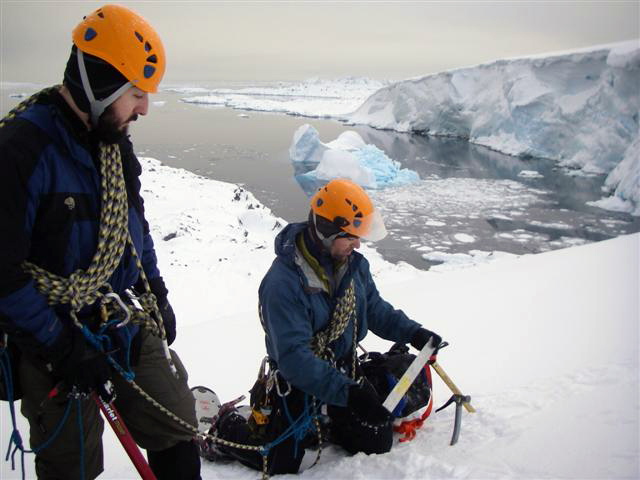
Photo Credit: Susannah Coates/Antarctic Photo Library
Jeff Braucher, left, and Ken Keenan conduct GSAR exercises on a glacier.
Due to Palmer’s marine location and the surrounding islands, the station has a small fleet of Zodiac boats for marine operations, which requires the need for an Ocean Search and Rescue (OSAR) team. Before coming to the station for the season, most of the winter-over crew trained in OSAR at Lake Powell in Arizona. There they learned the basics about search and rescue, such as how to use different safety equipment. Now they apply those basic lessons in monthly exercises around Palmer. Training sessions involve playing hide and seek using GPS, practicing landings in rough swells, learning the surrounding islands in the Palmer boating area, and improving general boating skills. With a glacier behind station, along with some of the icy terrain on the surrounding islands, Palmer also has a Glacier Search and Rescue (GSAR) team. The GSAR trains mostly on the glacier, learning different ways to work safely to rescue anyone who may, for example, have fallen down a crevasse, and then how to transport them either back to station or to a boat if on an island. The last emergency response team on station is the most important — the fire team. Just about everyone on station is involved with responding to a fire alarm. The same group that trained at Lake Powell also trained for a week in Arvada, Colo., learning the skills needed to keep a fire from spreading, and more importantly, how to find and save people who may be injured in a smoke-filled area. So we fill our days with not just our day-to-day jobs but also training and learning skills that we hope we never need to use beyond drills and exercises. With each drill, we learn new things and grow more confident in our ability to respond to a real emergency as needed and as safely as possible. |
Polies enjoy fresh veggies in dark of winterPosted May 8, 2009
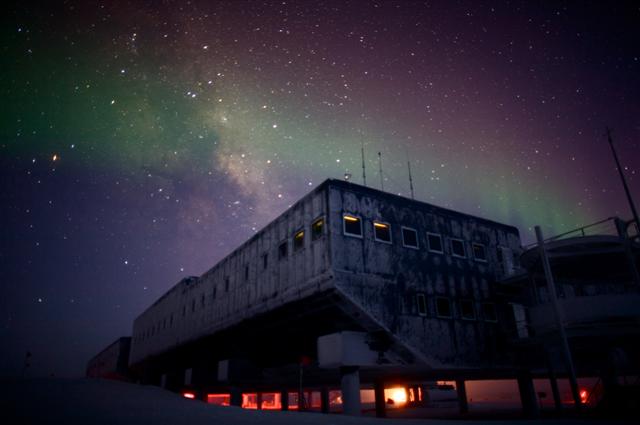
Photo Credit: Patrick Cullis/Antarctic Photo Library
Aurora shimmers in the night sky over South Pole Station.
As the South Pole winter moves toward its fourth month, the crew of 43, the smallest in a decade, has settled into a regular work schedule that provides maintenance for the station, troubleshooting, and scientific observation. The big story at South Pole Station The recent meteor shower peaked April 22, and appeared to come from the constellation Lyra, the harp, which is below our horizon. According to research done by our station doctor, Ella Derbyshire, these shooting stars are made of small dust particles left behind from the passage of Comet Thatcher. They heat up as they enter the atmosphere, and a few of them leave lingering, faintly glowing trails. The Lyrid shower Auroras “When this stream of electrons and protons impacts with our atmosphere, they excite the various gases, releasing excess energy that appears as light moving in shapes across the night sky. “The 11-year solar cycle affects the frequency and brilliance of the aurora we see. The sun is currently close to its solar minimum, producing a slight zephyr of particles. During the next five to six years, the sun’s activity will increase, culminating in large coronal mass ejections, which will light up the night sky with increasingly powerful aurora. Nevertheless, even with the sun at a minimum, the power and beauty of the aurora is still impressive here at the South Pole — a wonderful display.” 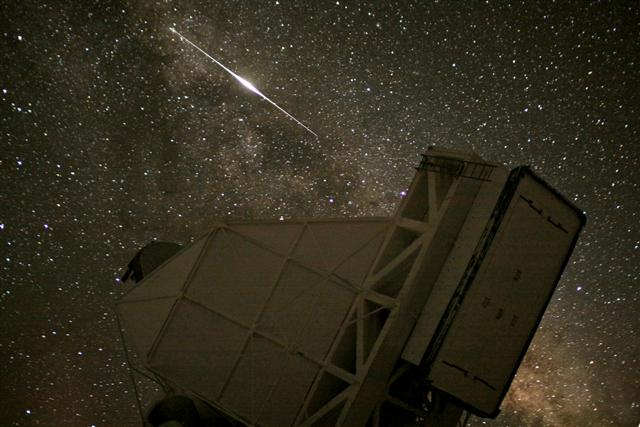
Photo Credit: Keith Vanderlinde/Antarctic Photo Library
An Iridium flare appears above the South Pole 10-meter Telescope.
Iridium flares “During the brief period when one of these panels is aligned so as to reflect sunlight to an observer, the satellite appears much brighter than usual,” he says. “The satellites are normally just barely visible to the naked eye, but can outshine the brightest stars in the sky during one of these 20-second flares.” Shirokoff adds that the satellites are 800 kilometers above the surface of the Earth, and even as it seems dark as night to our eyes from the ground, the airborne equipment can be in direct sunlight when the sun is below our horizon. Indoors, the South Pole Growth Chamber 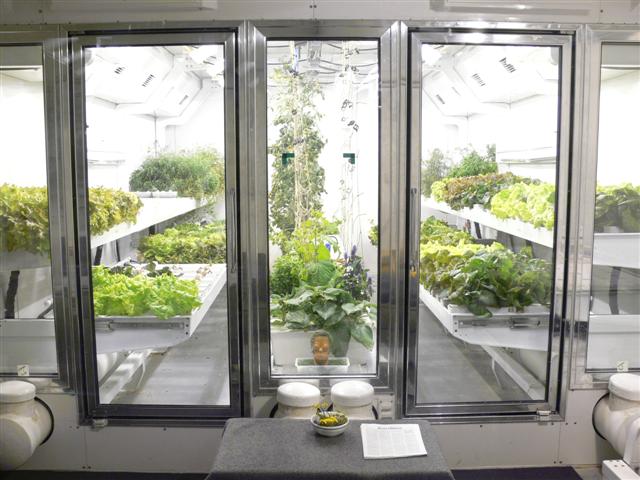
Photo Credit: Lane Patterson/Antarctic Photo Library
The South Pole Growth Chamber uses artificial lighting and hydroponics to grow fresh vegetables.
Joseph Romagnano, who, with a PhD in Crop Physiology from Utah State University (and refers to himself as Greenhouse Joe, South Pole Farmer) oversees the chamber, which is on the cutting edge of hydroponic technology. According to Joe, the chamber is constantly in the experimental stage, and is something we might someday see on space colonies where there is no natural sunlight, earth-like soil, or moderate outdoor temperatures — very much like conditions at Pole. In the first nine weeks of the 2009 winter, the greenhouse produced close to 340 pounds of freshies for the station. That means the crew enjoys newly harvested greens almost every night. The most prolific growers are lettuces, cucumbers, jalapeno peppers, basil and dill, but we have also enjoyed beautiful chard, mizuna, arugula, and even a handful of the first tiny, sweet Alpine strawberries, a first for the growth chamber, which was built during the winter of 2004. Some other crops are still growing and are expected to yield cilantro, bell peppers, the edible flower nasturtium, watermelon, and cantaloupe, among others. |
About the Sun

